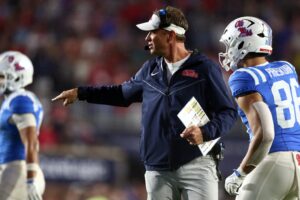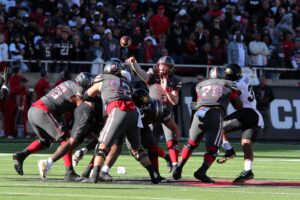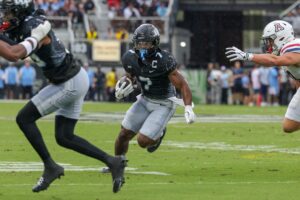At some point, the play-by-play of the post-mortem becomes less significant than the overall theme. Chip Kelly has gotten plenty of criticism over UCLA’s first three losses, fair or not. Friday night’s 38-16 loss at Colorado though was all about the lack of execution on the field, and not the schemes.
UCLA Tailspin Continues In Colorado
Kelly’s offensive choices in the loss to Fresno State two weeks got criticism from blog sites during the game, parents of players immediately following the game and fans and analysts for the week following. The first half Friday night showed signs of what many expected a Chip Kelly offense to be. There were players in motion on every play. Play calling was diverse. Quarterback Dorian Thompson-Robinson hit the edges and threw on the run. He even showed his scrambling ability with a 17-yard run. The offensive line was stabilized with the return of center Boss Tagaloa from a three-game suspension. That provided a touch of a running game, not with Kazmeir Allen, but with Josh Kelley who would finish the game with 124 yards on 12 carries.
The problem was, the flashes the Bruins showed in the first half, were just that; flashes. For all the improvement Thompson-Robinson showed, he also left points on the field with more misses on very makeable plays. There were open receivers overthrown by yards. There were receivers crossing the middle with passes thrown behind them. Thompson-Robinson finished the game 17 of 35 for 138 yards and a touchdown. The numbers are deceiving though without context. The lone touchdown was on UCLA’s second drive of the game. That means there was an endzone drought for the next 50+ minutes. And a handful of the completions and yards came in the football equivalent of garbage time, when the game was long decided. With five minutes left in the game, Thompson-Robinson was 12 of 24 for 96 yards. Those numbers much more indicative of the night he had.

For a brief time, the play-by-play did matter. Thompson-Robinson hit Michael Ezeike for an 11-yard touchdown pass early in the first quarter. The connection was a highlight both for the great touch shown by the freshman quarterback and great hands by the lunging freshman receiver.
The Bruins had a short-lived 7-0 lead. On the next series, the UCLA defensive secondary got burned by Colorado receiver Laviska Shenault. He and quarterback Steven Montez connected for a 57-yard touchdown pass as he blew by defensive back Darnay Holmes for the 7-7 tie.
UCLA would add a 21-yard J.J. Molson field for a 10-7 lead at the end of the first quarter.
The front seven of the UCLA defense was doing a good job keeping the Colorado offense contained to the middle of the field. But that is not the strength, nor the strategy for the Buffaloes. And once the UCLA offense started stalling out and producing more and more three-and-outs, it opened the playbook for Colorado’s offense.
The Buffaloes started using the speed of Montez to spread the field. He was able to fool the defense with misdirection plays, including the 10-yard run he had himself for a touchdown and a 14-10 second quarter lead.
Molson would add a career best 50-yard field goal and the Colorado lead would be cut to one by halftime, 14-13.

Still, you could see the growing trend where UCLA was struggling to convert opportunities on offense. Meanwhile Montez was a highly efficient 13 of 15 for 131 yards and a touchdown. He also had 30 yards and a touchdown on the ground. The speed and diversity and execution of the Colorado offense was a photo set of what UCLA fans have been hoping for on their side.
The gap predictably grew in the second half. The Bruins got another Molson field goal, this one from 40 yards, and they had a 16-14 led. It was their first second half lead of the season. But while UCLA was kicking field goals, Colorado was putting together drives of four or five minutes and coming up with touchdowns. Shenault took the snap in the wildcat formation and ran it in from one-yard out for 21-16 lead. That was a wrap for the night.
UCLA went three-and-out on the next drive. That put a gassed defense back out on the field with little rest in the high Colorado altitude. It became the story of the second half. There was no way the defense was going to keep up with the speed of the Colorado offense, when the UCLA offense could not maintain a drive of more than three or four plays.
Colorado running back Travon McMillian scored on a six-yard touchdown run that capped a 5:45 drive for the Buffaloes and gave them a 28-16 lead. The Bruin defenders were tackling air at this point.
Colorado outscored UCLA 24-3 in the second half. So, what was the difference between the halves? Thompson-Robinson had a curious explanation after the game. “The offense just got put in certain situations where it is hard to move the ball, especially with Colorado’s game plan. They like to blitz on third down a lot. So, it’s hard on third down when you have to gain a lot to push the ball downfield.” Executing plays on first and second down so that you are not in third and long will usually keep a defense from blitzing too much.
Even with UCLA down by 15 with plenty of time left in the third quarter, Thompson-Robinson had a wide-open Kyle Philips on third and short. But instead of hitting him in stride, the pass was behind the receiver’s back shoulder. The potential drive ended in a fashion pretty symbolic of the night for the offense. Closer than it was against Fresno State, but not close enough to matter on the scoreboard.
As Colorado was 3-0 going into the game, their opponents were a combined 1-10. It was unclear how good they truly were. The Bruins are now 0-4 and their opponents are now a combined 14-1 going into Saturday’s game. There are plenty of paints available to paint a picture of the struggles. It doesn’t get easier with Washington coming to the Rose Bowl next week.






